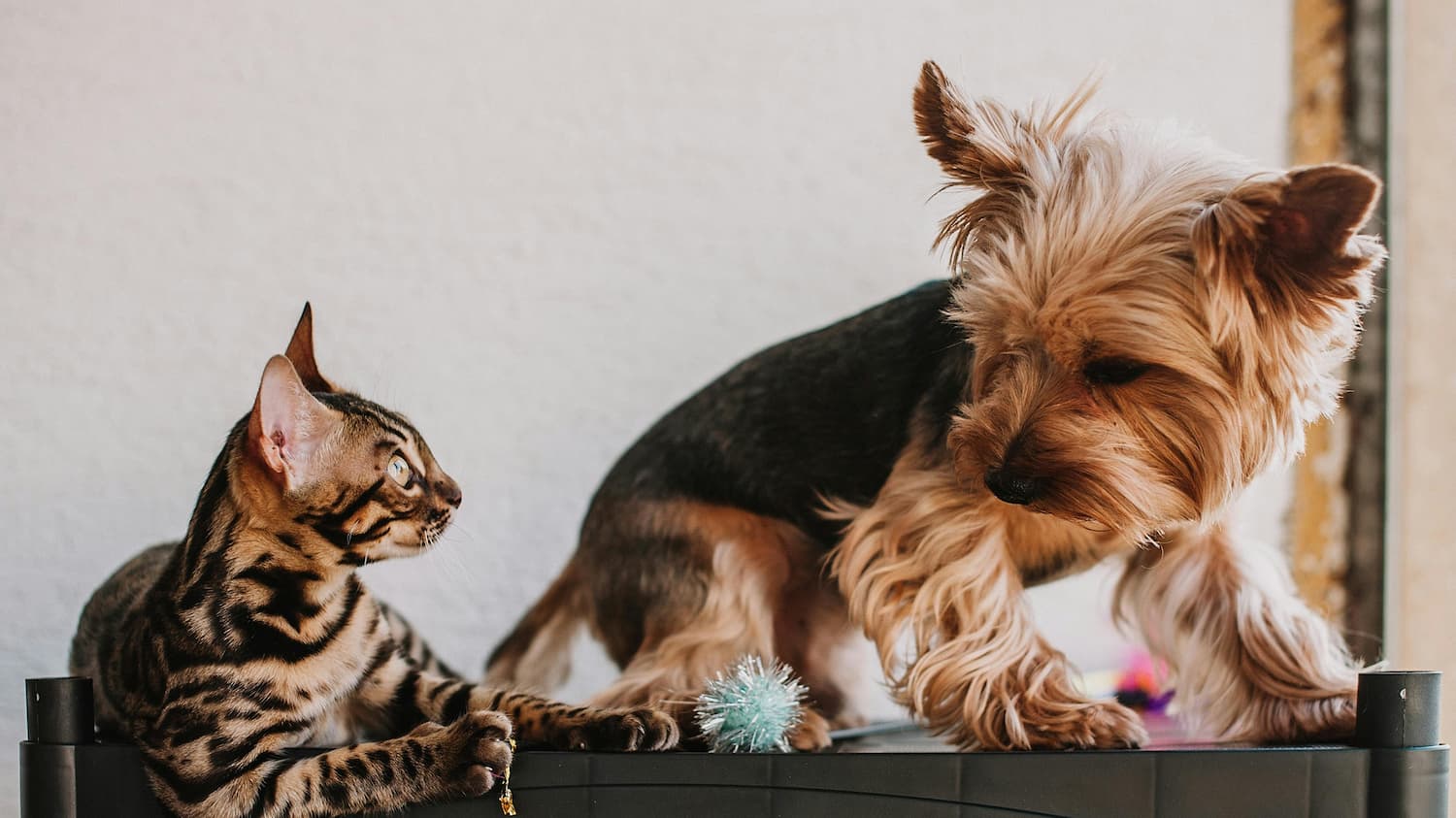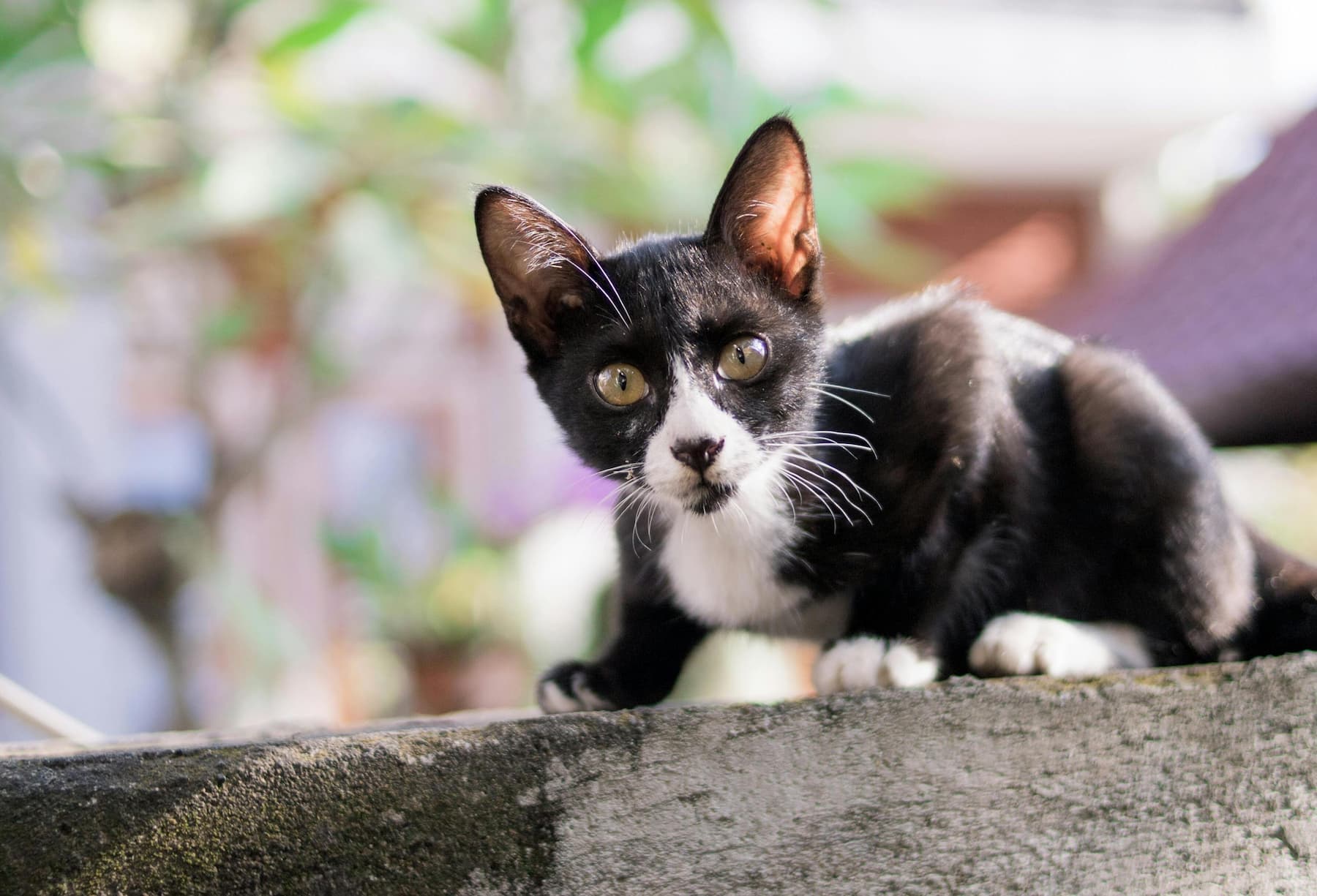If you find your cat keeps peeing on the dog bed then you’re probably feeling frustrated and wondering what’s causing your kitty to behave this way. When cats urinate in strange places, it can often mean they feel unsettled or unwell. Let’s look at why your cat uses your dog’s bed as a bathroom, and what you can do about it.
Reasons for a Cat Peeing on the Dog Bed:
- Territorial Marking
- Anxiety or Stress
- Medical Issues
- Litter Box Problems
- Seeking Attention
- Scent Confusion
1. Territorial Marking
Urinating in a particular location on purpose is a means of communication with other felines. This type of cat behavior is known as territorial marking (or urine marking or spraying). This expression stems from when cats live in the wild or outdoors. Often, urine marking can indicate a cat’s readiness to mate, but it comes with other explanations, too.
The Need to Feel Safe
When a cat is found urinating on a dog bed, they are sending certain messages like “this space is mine” or “I’m feeling anxious.” The most plausible explanation for why your cat is peeing on your dog’s bed is that it gives the cat a sense of confidence and safety.
Even Neutered Cats Mark Their Territory
Here’s another example: A neutered male cat peeing on a dog bed can be marking his presence. That’s because, despite being sterilized, he still feels a strong urge to assert his dominance. Neutering can reduce this behavior, but about 10% of neutered males and 5% of spayed females continue to spray. This behavior can also be aggravated by stress or other animals nearby. For more on this topic, scroll down to watch a video presented by veterinarian Sarah Wooten, DVM, CVJ.
Please realize that your cat isn’t marking its territory in your dog’s space to be hostile or mean-spirited. Remember that, in the world of cats, they are typically nonchalant when faced with urine puddles left by another cat. They simply sniff it and go after them without a second thought.
2. Anxiety or Stress
The scenario of a cat peeing on a dog bed is the perfect example of what’s known as feline improper elimination. This problem often manifests as a physical sign of anxiety. If anxiety and stress are the problem, the cat may also strain painfully in the litter box and produce bloody urine, as well as pee inappropriately. You may notice them urinating in other strange places around the house (house soiling in general is a common complaint among cat owners).
How Stress Effects Cat Urination and Kidney Health
Cats under stress have a tendency to need to pee more frequently, so they might not be too choosy about where they do the deed. Anxious cats have more diluted urine because stress hormones like cortisol can disrupt their kidney functions. Kidneys concentrate and preserve urine, meaning that if they don’t work properly, the cat may need to urinate more frequently. Hormones like cortisol – produced when a cat feels anxious or stressed out – can negatively impact how the kidneys work. That’s why managing stress in our pets is crucial; we must prevent these disruptions and protect their overall kidney health.
3. Medical Issues
Certain health problems might cause a cat to start peeing on a dog bed, or in other places outside of their litter boxes. Feline interstitial cystitis (FIC), for example, is a chronic pain condition found in about 1-2% of domestic cats, particularly seniors. This condition can sometimes become so problematic that it results in them being given up or even euthanized.
Stressors That Can Trigger FIC
Cats with FIC usually show ongoing or returning signs of lower urinary tract issues – and they can get worse with stress. Typical stressors include loud noises, sudden movements, new places, and the presence of strangers or other animals. So consider if your cat is bothered by your dog, they may pee on your dog’s bed if they have a UTI or other underlying health concern. Take your cat to the vet for a checkup; only a veterinarian can diagnose and treat this problem.

4. Litter Box Problems
Besides health concerns causing a cat to urinate outside of their litter box, there could be issues with the litter tray itself. If your cat is peeing in the dog bed frequently, it may be because they don’t like their litter box, and they seek more comfortable, hygienic places to go. Your dog’s bed just happens to be warm, cozy, and clean.
What to Do
Ask yourself whether you need to clean the cat’s litter box more frequently, buy a different type of litter, or place the tray in a different location, that might be more favorable for the cat.
5. Attention-Seeking Behavior
When cats take bathroom breaks in inappropriate places, like urinating on the dog’s bed, it can be a classic cry for attention. Most felines seek attention from their owners because they crave interaction and affection. If you acknowledge your cat’s behavior of peeing on the dog bed by yelling or chasing them away, your cat might think “I’ll keep doing this because it gets me noticed.”
What to Do
When poor toilet manners occur because of a need for attention, it’s important to approach such behavior calmly. You need to understand what the underlying reasons are (for example, stress or medical issues). Address those instead of punishing your cat for soiling the dog bed.
6. Scent Confusion
Another reason for a cat peeing on a dog bed is that they are mistaken about the scent that attracted them there. A cat’s world is heavily influenced by smells. They rely on their noses to understand their environment, mark territory, and recognize other animals (or humans).
Here’s an Example:
Suppose some unfamiliar smells encroach on your cat’s space—you had a baby or the family got a puppy, for example—imagine the strange smells floating around that your cat tries to process! If your dog’s scent is present in their territory, they might feel the need to mark over it or act up to reassert their claim. Understanding this point can help you divide your cat’s and dog’s spaces so that your cat will return to peeing in the litter box, not on your dog’s bed.
Video: Rescue Cat Peeing on Dog’s Bed Post-Neutering (A Vet Explains)
What Is the Best Way to Get Cat Pee Out of a Dog Bed?
If you’re regularly finding cat urine in your dog’s bed, you’ll need a way to remove the stain as well as the smell. American Kennel Club recommends submerging your dog’s bed in warm water, pet-safe laundry detergent, and one cup of vinegar to remove all traces of cat pee (you can do this in the bathtub).
- For soft, plush beds, vigorously knead and squeeze the material and rinse it clean in warm water.
- Plastic beds come clean more easily; just use a sponge to wash them with the solution, then rinse.
If the stains and odor are too severe to remove, consider disposing of it and purchasing a waterproof bed for your dog, that is much easier to clean.
How Can I Keep My Cat off My Dog’s Bed?
Many cats enjoy sleeping on dog beds because they are warm and comfortable. But that doesn’t mean they should get too cozy and treat it as their own bed (or bathroom, for that matter). The best ways to keep your cat away from your dog’s bed are:
- Thoroughly wash the dog bed to remove all previous traces of cat pee, plus any other scents your kitty may find attractive.
- Make your cat’s space more inviting so they’ll be less inclined to seek comfort in other pet areas. For example, consider buying the Bedsure Cat House with a fluffy hanging ball and scratch pad—far more intriguing and cozy than Fido’s bed! Lure them to it by placing it in a quiet area of the house and adding some of their favorite toys (or a blanket with their scent).
- Encourage your cat to use their own space for sleeping and their litter box for potty duties. You can do this using the technique of positive reinforcement: offer plenty of healthy cat treats and lots of love choosing their quarters over the dog’s.
Final Thoughts
We’ve covered a few reasons why your cat may be peeing on your dog’s bed: they might be feeling a bit stressed or anxious, confused by the new scents invading their territory, or even drawing your attention to a health concern. Try making your cat’s own space more appealing and keeping all pet beds and litter trays clean and sanitized. Please don’t ignore potential health issues and speak to your vet if you are concerned about your cat’s inappropriate peeing behavior.
References:
- Stella, J., Croney, C., & Buffington, T. (2013). Effects of stressors on the behavior and physiology of domestic cats. Applied animal behavior science, 143(2-4), 157–163. https://doi.org/10.1016/j.applanim.2012.10.014
- Padodara, Ramesh. (2014). Olfactory Sense in Different Animals. The Indian Journal of Veterinary Science. 2. 1-14.
- He, C., Fan, K., Hao, Z., Tang, N., Li, G., & Wang, S. (2022). Prevalence, Risk Factors, Pathophysiology, Potential Biomarkers and Management of Feline Idiopathic Cystitis: An Update Review. Frontiers in veterinary science, 9, 900847. https://doi.org/10.3389/fvets.2022.900847
- Territorial Marking in Cats – Veterinarian Dr. Jacqueline Brister discusses urine marking in cats, why they do it, and offers suggestions to prevent the behavior.
- Marking and Spraying Behavior in Cats – Debra Horwitz, DVM, DACVB; Gary Landsberg, DVM, DACVB, DECAWBM; Ellen Lindell, VMD, DACVB.
- Feline Behavior Problems: House Soiling – Cornell Feline Health Center




